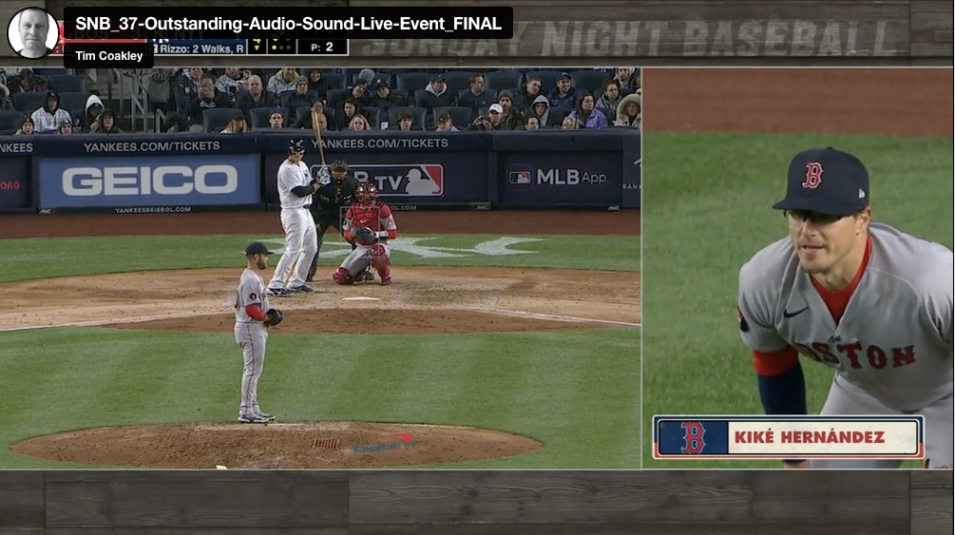‘Look Who’s Talking’ Baseball: ESPN Looks to Mic Up More Players on MLB Coverage
ESPN’s Sunday Night Baseball may get a larger cast of mic’d up outfielders
Story Highlights
Initially slow to put microphones on ballplayers compared with the NFL and the NBA, Major League Baseball has been making up for lost time in the past two seasons. With the 2023 season about to begin, ESPN’s Sunday Night Baseball is taking “talking baseball” to the next level.
Based on work done during Spring Training, when two outfielders were sometimes mic’ed up simultaneously, the broadcaster hopes to wire two outfielders for sound per game.
Based on work done during Spring Training, when two outfielders were sometimes mic’ed simultaneously, the broadcaster hopes to mic up two outfielders for sound per game. Each player will wear a Q5X PlayerMic transmitter, cushioned to prevent injury during falls; a Countryman B6 microphone element; and, for foldback, an earpiece developed by ESPN and its RF partner, CP Communications. Mics are clipped to the front of players’ jerseys; transmitters, simply popped into pants pockets.

ESPN’s Kevin Cleary: “Everyone always wondered what [outfielders] talk about out there during the game. Now we know.”
“This is a game-changer, no pun intended,” says Kevin Cleary, remote operations specialist, ESPN. “We had [former San Francisco Giant] Buster Posey asking [Arizona’s] Evan Longoria about dyeing his hair on live TV during a game! How much more interactive can you get?”
Moments like that and the one when Boston’s Kiké Hernandez was ruminating on two Bronx Bombers in scoring position and then bolted to catch up with a line drive, will be part of the network’s Sports Emmy Awards submission for this year.
Picture Follows Sound, for Once
Cleary says the success of having live mics on multiple ballplayers in the outfield during preseason broadcasts suggests that baseball will sound very different this year. In fact, he adds, it will also look different, because the production will regularly use a split screen with a closeup of the talking outfielder and a wider shot of the play on the field, a technique the broadcaster experimented with last season as part of the miked-up production.
Audio-connected ballplayers will be part of an environment resembling an espionage thriller more than a ballpark. ESPN and other broadcasters are scattering abundant microphones around the fields. In recent years, in-ground mics have been used around the mound and home plate for All-Star and postseason play. This season, the SNB team will plant a total of eight around home plate and the pitcher’s mound each week, in addition to deploying mobile and installed parabolic mics.
In fact, all that new sound from the field creates the need to keep sources as tonally differentiated as possible, to prevent overlap. That includes using EQ to keep speech separate from the game’s other effects elements, such as bat cracks and crowd sounds, and to make the wired ballplayer sound like, as Cleary puts it, “a fourth member” of the announce team, keeping the conversation part of what he calls “a symphony of sound” rather than an isolated moment in a game.
Audio management will be especially important since there is no submixer on SNB’s REMI production, which is directed and produced from ESPN’s Bristol, CT, facility, with EVS and graphics located there as well. Audio is mixed by A1s Brian Shannon onsite and Brian Deardorf in Bristol.
What won’t be heard this year are microphones in the bases, at least during regular-season play. Although the bags are getting bigger — part of a number of significant rule changes MLB has implemented this season — Cleary says the frequency with which the bases are changed out during games makes keeping them wired all the time too time-consuming.
Baseball Is Different
Baseball has been the latest to embrace what NFL calls Mic’d Up or, as ESPN more prosaically refers to it, “live in-game player interviews.” During 2018 Spring Training in Arizona, ESPN miked Boston’s Mookie Betts, who, during an in-game interview, saw a ball hit over his head and told fans, “I ain’t getting this one, boys.” Previously, the potential of miked players in the field was on display during the 2017 All-Star Game when the Nationals’ Bryce Harper bantered with Fox Sports announce team John Smoltz and Joe Buck.

Split screen shows Boston Red Sox outfielder Kiké Hernandez chatting with announcers before snagging a hit last year.
However, unlike the NFL, which looks to on-athlete audio mainly as part of the scrimmage script, and the NBA, where PlayerMics are part of the nat-sound foundation, baseball lends itself to narrative and conversation as part of a game’s sonic effects.
According to Cleary, ESPN, to which the league has given control over the on-field audio chatter, is sensitive to the potential for strategy talk by players during the game and is developing ways to address that. A brief profanity delay is, of course, in place.
The game’s pastoral ambience seems suited to allowing a left fielder to chat when not shagging long line drives. With multiple mics in the outfield this year and comments coming in on Twitter, though, the athlete/announcer dialogs of last season might soon resemble a left-field version of The View.
But, adds Cleary, bringing the players’ personalities to the air so vividly and intimately can enhance the game considerably, in terms of developing fan engagement and even a player’s own brand.
“It’s reinvigorating passion for the game by anyone who hears it,” he says. “Everyone always wondered what they talk about out there during the game. Now we know.”
